One of the things that has surprised me the most about Poland is the lack of Jews. I guess I was naive to think that there would still be a large Jewish population here, especially after World War II. But in all reality, there are no Jews here. At all.
So many of my friends back home who are Jewish have Polish roots, as do I. Poland had the largest Jewish population in eastern Europe before the war and now it almost doesn’t exist. A few posts ago I wrote about how we searched and searched in vain for the only synagogue left in Warsaw. We didn’t find it and it was very surprising to me that no one could even point us in the direction it might be. It really goes to show how no one knows anyone who is a part of the Jewish population in Warsaw, probably because it doesn’t really exist anymore.
In Krakow however, it is a slightly (very slightly) different story. There has always been a Jewish Quarter here, known as Kazimierez. Since Krakow was not destroyed as Warsaw was during and after the war, the Jewish Quarter still stands today. With this designated historical section of the city, one would think you would also find a thriving Jewish population in the city. But alas, it doesn’t exist here as well.
We went on a walking tour of Kazimierez one day last week and our guide explained to us how there used to be as many as 600,000 Jews living in Kazimierez before the war. The current population is about 140-400 Jews. However, even with this tiny Jewish population, they still have three rabbis (pretty cool!).
We got to see four synagogues in all during our time in Kazimierez. The first was (below) was one of the older synagogues in the area. No longer an active congregation, it serves as a museum to the Jewish people in Kazimierez today. The white part of the building was added later on to accommodate the women in the Orthodox congregation (since traditionally men and women sit separately).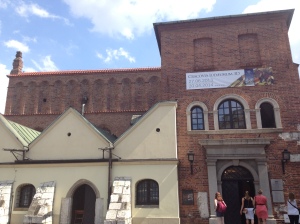
The next synagogue we went to is still active, though it is in great need of some renovating. On the grounds with the Jewish Cemetery in Krakow, the sanctuary is very small and many of the decorative paintings inside were destroyed during the war and haven’t really been redone. The bimah is intact though and still looks beautiful.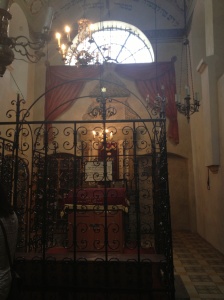
The Jewish Cemetery is something entirely of its own right. Very well kept up, it’s age is very apparent. The headstones are deteriorating and many of them have support slabs behind them to keep them up and others have metal little “roofs” over them so that the snow during the winter does not destroy the stone. Many of the headstones have a rounded top and the walls surrounding the Warsaw Ghetto had this pattern to them as a sort of mocking to the Jews and to remind them of what was in store for them, namely death. The walls surrounding the cemetery are created using headstones that were destroyed during the war by the Nazis. They are all broken up, but many are still readable. They have been put together in a sort of mosaic to remember those graves that are no longer visible. I think it’s a great gesture of remembrance.
The third synagogue on our trip was the current Chabad congregation in Krakow. This really amused me as I left home with a Chabad House down the street from my house and here in Poland was the same exact thing. This sanctuary was kept in much better condition and many of the paintings and art on the walls was completely restored. Since this was an active synagogue, there was a little store out front that sold kosher snacks and food from Israel as well as a gift shop that sold mezuzahs, menorahs and little trinkets from Israel. Since the Jewish population in Krakow right now is so small, I wonder how many people they actually have come into their store or if it is just for tourists like us coming through.
The last stop on our tour of Kazimierez was the facade of the oldest synagogue in Krakow. This building was no longer used actively by a congregation, but it used to house the Hebrew School and Yeshiva for the area. Now I believe it is a museum, although since we did not go inside I do not know for certain.
I was very surprised by the Jewish presence (and non-presence) in Krakow. I thought there would be more Jews, but even though the community as very small, there were obvious signs all around Kazimierez. This was where parts of the movie “Schindler’s List” were filmed (and we also got to tour Schindler’s factory, which is now a wonderful museum about the war and the Jewish ghetto in Krakow as well as how Schindler saved thousands of Jews with his lists).
This brings us to back to Warsaw, where we were able to tour the ghetto at the end of our third week in Poland. I use the phrase “tour the ghetto” very loosely. What was the Warsaw Ghetto has been completely destroyed and there is really nothing left of it. If you were just walking around the parts of the city that used to be incorporated into the ghetto, you would never know. The city of Warsaw has put up markers around the area though, marking the boundaries of the ghetto and where the walls used to be.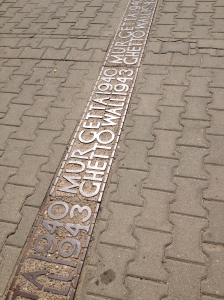
Being inside the ghetto area had the least effect on me compared to any of the other Jewish sites so far. It is hard to remember you are standing inside the ghetto walls as you walk around because it has all been redone and there are hardly any markers, save a few plaques here and there. The Jewish theatre, where Jews enclosed in the ghetto were able to perform theatre and musical concerts is now a movie theatre with one plaque describing what happened previously in that building.
There is also a grave site and memorial for the fighters in the Warsaw Ghetto Uprising. It is significantly less grand than other memorials around the city. Others have statues and guarded tombs – this one had a few stone steps and a grassy mound with one marker on the top. There is a statue commemorating the uprising and it is located at the new museum of Jewish history.
The most moving area in the ghetto came at the end of the tour. There is a memorial to those who were forced to live within the ghetto walls and who then lost their lives at the hands of the Nazis when they were transferred to the concentration camps. Written in Polish, Hebrew and English, there are a few large walls of memorial to these Jews (some 300,000). Inscribed on one wall are common Yiddish names to memorialize those who lost their lives. Even though these names are just generalizations, it really hit home with me as I read the wall and saw the first names or Hebrew names of almost all of my relatives. Listed were Leopold, Rachel, Zawel, Mordecai, Anastasia, Ludwik, David, Deborah (the Hebrew name or first names of myself, my father, grandfather, sister, great-uncle, uncle and aunt) among others. This was the first time that day that it really hit me that this ghetto was my past, even if I had no immediate family who were forced to live in it. These names very easily, in another life, could have been me.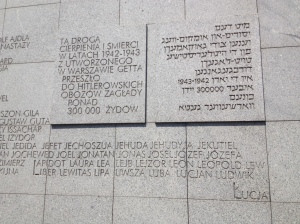
Keeping all that in mind this trip has been hard for me. I don’t want to think about all the tragedies the Jewish people went through just 70 years or so ago, yet everywhere you look here in Poland there is a reminder of what happened. We can’t forget. It is our duty to make sure it doesn’t happen again.
PS. We finally found the Warsaw synagogue!
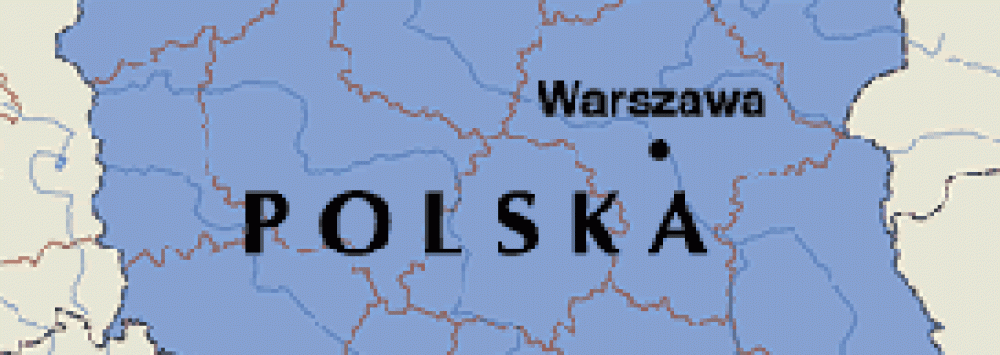
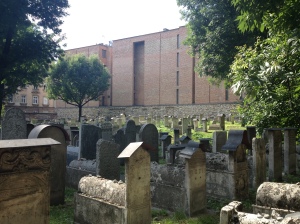
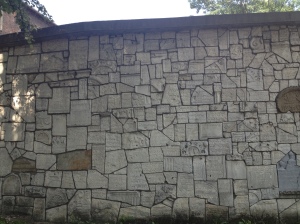
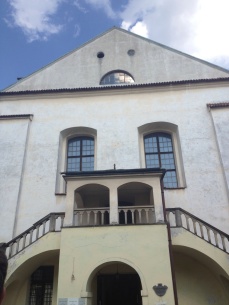
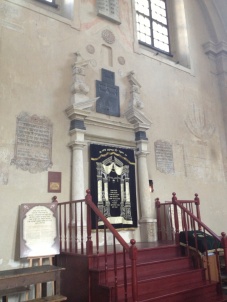
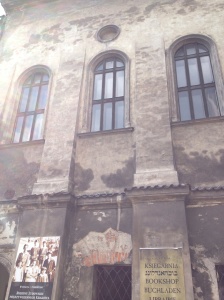
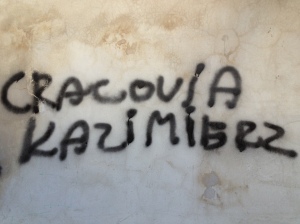
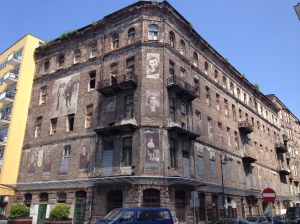
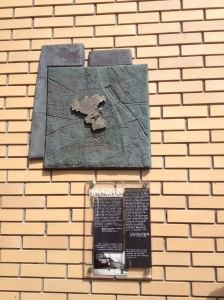
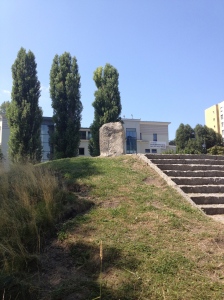
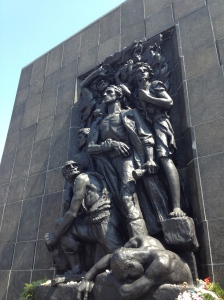
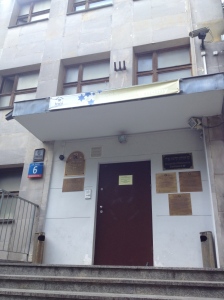
It’s really interesting to follow your trip.
I have to admit that I found Warsaw to be quite depressing. It’s obvious that most of the city was destroyed during WW II. And of course the decimation of the Jewish population is particularly saddening. Finally, there’s the bizarre Stalinist Palace of Culture and Science glaring down at the city.
I hope we never forget the horror of the Nazis but it is unfortunately human nature to forget and then repeat our worst history.
Dear Rosie,
I thank you for putting this remarkable piece together. I learned so much as I traveled the diffiuclt journey of the painful past of the Jews of Poland with you. Your comments and your pictures are just unbelievable and I know this trip will be life changing for you.
You are so blessed and I appreciate that you share your blessings with so many. Needless to say, your grandmother would be kvelling and we would be talking about your trip non stop iif she was still here.
You are a credit to the Leopold name and I am honored to share in your friendship and that of your amazing family.
With appreciation, admiration and affection, Pat
Those of us who are of Polish descent share the tragedies even though we are born Polish Catholics. Or we’re we? Perhaps one of our Polish ancestors was Jewish and was sent to live with a Catholic family. Stayed with the mother of my deceased cousin’s wife when we visited .She had the concentration camp number embedded on her arm,she was A Catholic Pole,still alive now and about 94.